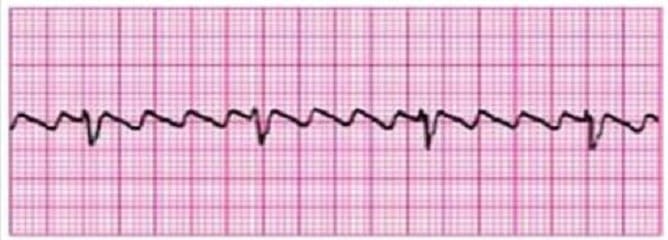Exam Details
Exam Code
:ACLSExam Name
:Advanced Cardiac Life SupportCertification
:Test Prep CertificationsVendor
:Test PrepTotal Questions
:301 Q&AsLast Updated
:Apr 11, 2025
Test Prep Test Prep Certifications ACLS Questions & Answers
-
Question 191:

Identify the rhythm by selecting the best single answer:
A. Normal sinus rhythm
B. Sinus tachycardia
C. Sinus bradycardia
D. Reentry supraventricular tachycardia E. First-degree AV Block
F. Second-degree AV Block (Mobitz 1 Wenckebach)
G. Second-degree AV Block (Mobitz II Block)
H. Third-degree AV Block
I. Atrial fibrillation
J. Atrial flutter
K. Monomorphic ventricular tachycardia
L. Polymorphic ventricular tachycardia
M. Coarse ventricular fibrillation
N. Fine ventricular fibrillation
O. Agonal rhythm/asystole
P. Pulseless electrical activity
-
Question 192:
What is the evaluation and treatment for a patient with pulseless electrical activity?
CPR, rapid fluid challenge, oxygen, check breath sounds bilaterally, and give epinephrine.
The three most treatable causes of pulseless electrical activity are (Choose three.):
A. massive pulmonary embolism
B. cardiac tamponade
C. hypovolemia
D. tension pneumothorax
E. massive myocardial infarction
-
Question 193:
A 70-kg emergency department patient has pulseless electrical activity. An IV is started and a saline infusion is begun. What should the first treatment be?
A. lidocaine 70 mg
B. epinephrine 1 mg IV
C. verapamil 5 mg IV
D. sodium bicarbonate 1 ampule
-
Question 194:
T/F: Propranolol increases the pumping function of heart muscle.
A. True
B. False
-
Question 195:
A patient complains of shortness of breath and chest pain radiating to the neck. Blood pressure is 80/50 mm Hg and the respiratory rate is 40 per minute. Oxygen and an IV has been started. The monitor shows the following rhythm. What should the next treatment be?

A. carotid massage
B. lidocaine
C. sedation, then synchronized cardioversion
D. adenosine
-
Question 196:
T/F: Epinephrine increases cerebral and myocardial blood flow during CPR.
A. False
B. True
-
Question 197:
T/F: Epinephrine increases coronary perfusion pressure.
A. True
B. False
-
Question 198:

Identify the rhythm by selecting the best single answer:
A. Normal sinus rhythm
B. Sinus tachycardia
C. Sinus bradycardia
D. Reentry supraventricular tachycardia
E. First-degree AV Block
F. Second-degree AV Block (Mobitz 1 Wenckebach)
G. Second-degree AV Block (Mobitz II Block)
H. Third-degree AV Block
I. Atrial fibrillation
J. Atrial flutter
K. Monomorphic ventricular tachycardia
L. Polymorphic ventricular tachycardia
M. Coarse ventricular fibrillation
N. Fine ventricular fibrillation
O. Agonal rhythm/asystole
P. Pulseless electrical activity
-
Question 199:

Identify the rhythm by selecting the best single answer:
A. Normal sinus rhythm B. Sinus tachycardia
C. Sinus bradycardia
D. Reentry supraventricular tachycardia
E. First-degree AV Block
F. Second-degree AV Block (Mobitz 1 Wenckebach)
G. Second-degree AV Block (Mobitz II Block)
H. Third-degree AV Block
I. Atrial fibrillation
J. Atrial flutter
K. Monomorphic ventricular tachycardia
L. Polymorphic ventricular tachycardia
M. Coarse ventricular fibrillation
N. Fine ventricular fibrillation
O. Agonal rhythm/asystole
P. Pulseless electrical activity
-
Question 200:

Identify the rhythm by selecting the best single answer:
A. Normal sinus rhythm
B. Sinus tachycardia
C. Sinus bradycardia
D. Reentry supraventricular tachycardia
E. First-degree AV Block
F. Second-degree AV Block (Mobitz 1 Wenckebach)
G. Second-degree AV Block (Mobitz II Block)
H. Third-degree AV Block
I. Atrial fibrillation
J. Atrial flutter
K. Monomorphic ventricular tachycardia
L. Polymorphic ventricular tachycardia
M. Coarse ventricular fibrillation
N. Fine ventricular fibrillation
O. Agonal rhythm/asystole
P. Pulseless electrical activity
Related Exams:
AACD
American Academy of Cosmetic DentistryACLS
Advanced Cardiac Life SupportASSET
ASSET Short Placement Tests Developed by ACTASSET-TEST
ASSET Short Placement Tests Developed by ACTBUSINESS-ENVIRONMENT-AND-CONCEPTS
Certified Public Accountant (Business Environment amd Concepts)CBEST-SECTION-1
California Basic Educational Skills Test - MathCBEST-SECTION-2
California Basic Educational Skills Test - ReadingCCE-CCC
Certified Cost Consultant / Cost Engineer (AACE International)CGFM
Certified Government Financial ManagerCGFNS
Commission on Graduates of Foreign Nursing Schools
Tips on How to Prepare for the Exams
Nowadays, the certification exams become more and more important and required by more and more enterprises when applying for a job. But how to prepare for the exam effectively? How to prepare for the exam in a short time with less efforts? How to get a ideal result and how to find the most reliable resources? Here on Vcedump.com, you will find all the answers. Vcedump.com provide not only Test Prep exam questions, answers and explanations but also complete assistance on your exam preparation and certification application. If you are confused on your ACLS exam preparations and Test Prep certification application, do not hesitate to visit our Vcedump.com to find your solutions here.